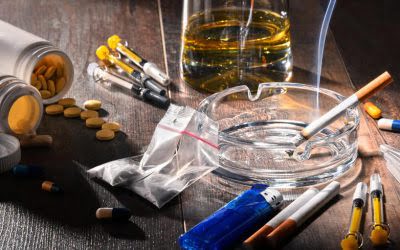Sober living
How Does Alcohol Affect Dopamine Levels in the Brain?
If you drink for long periods of time, it can cause depression, and when you abruptly stop drinking, it can cause anxiety,” says Dr. Anand. Sign up to get tips for living a healthy lifestyle, with ways to fight inflammation and improve cognitive health, plus the latest advances in preventative medicine, diet and exercise, pain relief, blood pressure and cholesterol management, and more. We are a community of more than 103,000 authors and editors from 3,291 institutions spanning 160 countries, https://fintedex.com/top-5-advantages-of-staying-in-a-sober-living-house/ including Nobel Prize winners and some of the world’s most-cited researchers. Publishing on IntechOpen allows authors to earn citations and find new collaborators, meaning more people see your work not only from your own field of study, but from other related fields too. Open Access is an initiative that aims to make scientific research freely available to all. It’s based on principles of collaboration, unobstructed discovery, and, most importantly, scientific progression.
- Some addictive substances affect dopamine directly, whereas alcohol and other drugs have an indirect effect.
- The FIC specifically facilitates access to attention and working memory resources when a salient event is detected and regulates reactivity to salient stimuli [113, 114].
- Marco Leyton, a professor and addiction researcher at McGill University’s Department of Psychiatry, said in a 2013 press release that participants more at risk for developing alcoholism had “an unusually large brain dopamine response” when they took a drink.
- He works with patients suffering from Substance Use Disorder to evaluate their medication needs and prescribe treatments accordingly.
- The mesolimbic system originates primarily in the A10 cell group and extends to the ventral striatum, which includes the nucleus accumbens (NAc) and the olfactory tubercle (OT).
How Does Alcohol Affect Dopamine Levels?

This presynaptic influence is part of the tonic-nonsynaptic mode of dopaminergic signal transmission. Nonetheless, alcohol shared properties with classical depressants, like Valium. Experiments in mice showed that when given Valium regularly, not only did they develop a tolerance to it, but they also developed an increased tolerance to alcohol. Called cross-tolerance, it indicates that both drugs act at the same receptor, the GABA receptor. Mounting evidence suggested that alcohol acted at GABA receptors, but research had still been unable to pin down a specific mechanism. However, studies have found that the specific effects depend not just on how much someone drinks, but also on whether blood alcohol content (BAC) is rising or falling.
Does alcohol automatically capture drinkers’ attention? Exploration through an eye-tracking saccadic choice task

Two-factor ANOVAs (stimulation intensity and treatment group) were used for the input–output curve experiments examining dopamine release. For the dopamine uptake rate (Vmax) data, two-factor ANOVAs (treatment and brain region) were used. 4, the final quinpirole treatment time points (i.e., after 30 min in quinpirole) were analyzed with a two-factor ANOVA (treatment group and region). For the determination Sober House of dopamine transient uptake kinetics, the modeling module in DEMON was used as previously described [30]. Briefly, the dopamine affinity for the transporter (Km; set to 0.16 µM) was held constant and the dopamine peak height was determined empirically for each file and used for determination of Vmax (dopamine uptake rate), which was altered to best fit the empirically obtained dopamine transients.
Dopamine and Alcohol Dependence: From Bench to Clinic
This effect has been examined in greater detail elsewhere and was found to be driven primarily by the first month of drinking, post abstinence [32]. Nonetheless, it is interesting to note that the previously reported drinking data from Cohort 3 rhesus macaques showed an alcohol deprivation effect-like phenomenon in which subjects robustly increased their ethanol consumption for 1 month following each abstinence period [32]. Furthermore, the trend toward decreased dopamine release in the males with no abstinence might have become significant had those subjects been put through abstinence periods like the male subjects in Cohort 3 of this study. In addition, it is well substantiated that alcohol affects dopamine directly via the NAc and VTA as well as through indirect activation of the mesolimbic pathway via interaction with other reward‐related brain regions and neurotransmitters. Given dopamine’s pivotal role in the development and maintenance of alcohol dependence, medications targeting dopamine does constitute an important area of research.
- To examine differences between tonic and phasic release, we applied stimuli at varying frequencies before and after the application of the β2 subunit-containing nAChR antagonist, dihydro-β-erythroidine hydrobromide (DHβE; 1 µM).
- The prefrontal cortex also plays a role in preventing aggressive behavior, so this might help explain the relationship between alcohol and violence (see my last post).
- A study limitation is that, although our results indicated P/T depletion effects on the brain and behavior, we did not directly measure dopamine or dopamine metabolite levels.
- A night of drinking can cause uncomfortable symptoms like diarrhea, nausea, and vomiting.
- We further explored the effect of long-term ethanol consumption on striatal cholinergic systems by examining gene expression of several nAChR subunits (α4, α5, α7, and β2) and markers for cholinergic interneurons (ChAT and vAChT).
- These data are supported by the findings that olanzapine reduces craving for alcohol at baseline for both individuals with the DRD4 shorter and longer allele, but only reduces craving after exposure to alcohol cues and after a priming dose of alcohol for individuals with the DRD4 longer allele [166].
- We are also thankful to the members of the Sara Jones laboratory at Wake Forest University and the Laboratory for Integrative Neuroscience at NIAAA for their support and helpful discussions.
- The involvement of the dopamine D1, D3, D4 and D5 receptors falls outside the scope of the present review but has previously been reviewed elsewhere [20].
- In addition, aripiprazole has been shown to reverse alcohol‐induced place preference and anxiety‐like behaviour in mice [182].
- In addition, microdialysis studies in freely moving outbred rats show a decreased dopamine output in the NAc, compared to age‐matched alcohol‐naïve controls, following 7 weeks [104] and 10 months [29] of voluntary alcohol consumption.
We further explored the effect of long-term ethanol consumption on striatal cholinergic systems by examining gene expression of several nAChR subunits (α4, α5, α7, and β2) and markers for cholinergic interneurons (ChAT and vAChT). We found no significant differences in ChAT or vAChT expression between control and alcohol treated subjects, suggesting that long-term alcohol consumption does not adversely affect cholinergic interneurons. Similarly, we did not see any significant changes in mRNA levels of the nAChR subunits. This may be due to the ubiquitous expression of nAChRs in the striatum which would limit our ability to detect changes in specific cell types. Nonetheless, further work and more subjects per group (particularly in female subjects) are required to determine if the alcohol-induced changes in dopamine release are attributable to changes in the function of the presynaptic dopamine terminal or other factors that indirectly modulate dopamine release.
Alcohol in Your Body
The mechanism of action is, however, not completely understood, and although in vitro studies indicate that OSU6162, like aripiprazole, acts as a partial agonist at D2 receptors [191, 192], behavioural studies have failed to demonstrate any intrinsic activity of the compound ([195]). Instead it has been suggested that OSU6162 produces functionally opposite effects by acting as an antagonist at both presynaptic autoreceptors and postsynaptic D2 receptors [189, 193–195]. Based on the hypothesis that OSU6162 can counteract both hyper‐ and hypo‐dopaminergic states, the compound has recently been evaluated in both animal models modulating alcohol‐mediated behaviours as well as in a placebo‐controlled human laboratory study in alcohol‐dependent patients.
- In addition, it is well substantiated that alcohol affects dopamine directly via the NAc and VTA as well as through indirect activation of the mesolimbic pathway via interaction with other reward‐related brain regions and neurotransmitters.
- Aftercare may include community-based and family-based support systems, mutual-help groups, alumni events, and more.
- The nigrostriatal system originates in the A9 cell group and extends to the dorsal striatum, which includes the caudate nucleus and putamen (CPU).
- Because GABA is the primary inhibitory neuron in the brain, it can affect virtually every system.
- Interestingly, the treatment effects of OSU6162 were driven by those individuals with high level of baseline impulsivity, corroborating previous results with the partial dopamine D2 agonist aripiprazole [185].
A series of human imaging studies over the last decade have demonstrated that alcohol [93, 94] as well as other drugs of abuse [95] increase striatal dopamine release. This is further corroborated by the findings that self‐reported behavioural measures of stimulation, euphoria or drug wanting by alcohol correlates with the magnitude and rate of ventral striatum dopamine release [96–98, 94, 99, 100]. These studies clearly substantiated the involvement of dopamine in the reinforcing effects of alcohol and closely mimicked the findings of the preclinical studies. The β2 subunit-containing nAChR antagonist DHβE (1 µM) depressed dopamine release in caudate and putamen of control and ethanol subjects (A).
Pain and reward circuits antagonistically modulate alcohol expectancy to regulate drinking
As PhD students, we found it difficult to access the research we needed, so we decided to create a new Open Access publisher that levels the playing field for scientists across the world. By making research easy to access, and puts the academic needs of the researchers before the business interests of publishers. 5Aminomethyl propionic acid, or AMPA, is a chemical that specifically activates this glutamate-receptor subtype. 4N-methyl-d-aspartate, or NMDA, is a chemical that specifically activates this glutamate-receptor subtype. 1The term “dopaminergic” refers to both the neurons and the signaling processes that use dopamine. A reward (e.g., food) usually is a complex stimulus having primary (e.g., calories) as well as secondary (e.g., taste and smell) motivational properties.
